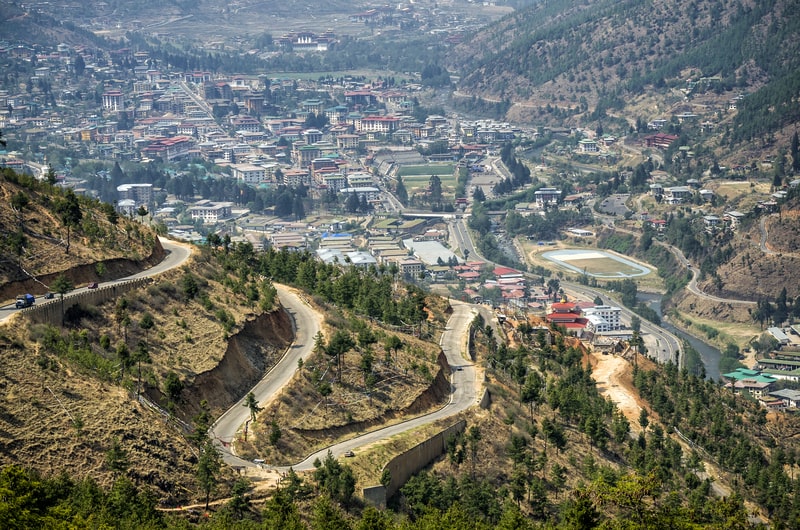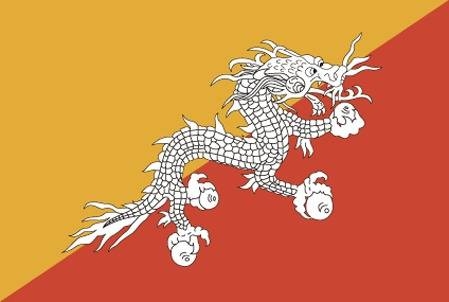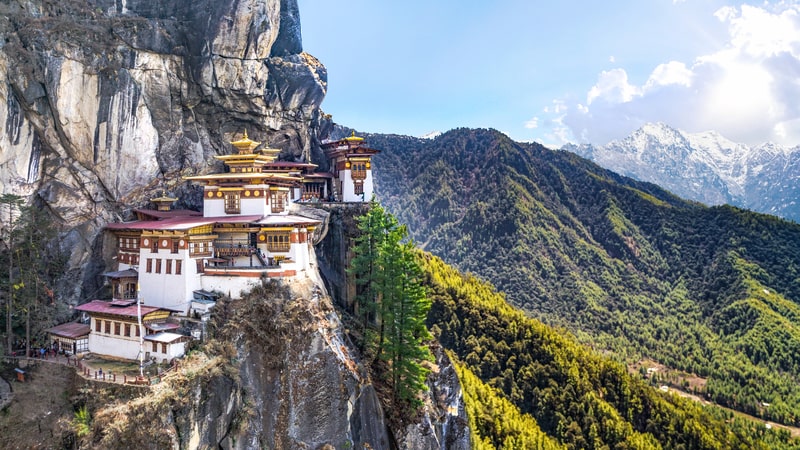Last updated on February 27th, 2022
Bhutan is a tiny kingdom nestled high in the Himalayas. It is landlocked by its more prominent neighbours, China (Tibet Autonomous Region) to the north and India to the east. Officially, Bhutan is called the Kingdom of Bhutan. It is a constitutional monarchy that, while democratic, is ruled by a king, who is also its head of state. The executive power of the nation rests on the cabinet, which is headed by its prime minister. With these interesting facts about Bhutan, let us learn about its history, geography, people and much more.
1. The name Bhutan has a vague history, although it is believed to be derived from the term Böd, a Tibetan endonym. The tradition is that it was transcribed from the Sanskrit Bhota-anta (shortened to Bhotant), which means the “end of Tibet”. This is because Bhutan is situated in the southern edge of the Tibetan plateau. Another interpretation of the origin of the country’s name is that it may have come from another Sanskrit word, “Bhu-uttan”, which means highlands.
2. The old name of Bhutan was Lho Mon. Lho, meaning south and mon, meaning darkness. As such, it was known as the Southern Land of Darkness. It was so-called because in ancient times, Buddhism already had a strong following in India and Tibet but not in Bhutan, so it was not yet ‘enlightened’ by religion.

3. Bhutan has had an official name since the 17th century. It’s “Druk yul”, which means the Drukpa Lineage country. This name in turn means the “Land of the Thunder Dragon”. This is thanks to the loud sound of thunder in the region during fierce storms.
4. Bhutan’s current king is Jigme Khesar Namgyel Wangchuck, who is also known as Druk Gyalpo, which means Dragon King. However, he is more affectionately known as the People’s King because of his humble nature. He personally talks to his people and has reportedly met most of the country’s citizens.
5. Polygamy is legal in Bhutan. In fact, one of their past kings married four sisters. These days, however, the practice is becoming uncommon, although divorce and remarriage are not.
6. Bhutan is predominantly Buddhist. The religion was introduced by Guru Padmasambhava during the 8th century. Prior to that, the dominant religion was Bonism, which involved the worship of nature in all its forms. Bonism is still practiced in some remote areas in Bhutan.
7. Due to its isolated location, Bhutan remained inaccessible and cut off from outsiders for many centuries. It only began to open its doors to visitors in the 1970s.
Flag of Bhutan

8. The first recorded visit by foreigners to Bhutan was in 1627. Two Portuguese Jesuits headed to Tibet stopped in Bhutan and met Ngawang Namgyal, who was the 18th throne-holder or Drukpa at the time. They gave gifts consisting of a telescope, firearms, and gunpowder.
9. Bhutan is believed to have been inhabited as early as 2000 B.C., as evidenced by ancient weapons, stone tools, and large stone structure remnants.
10. Bhutan’s official language is Dzongkha, meaning “language of the palace”. It is the country’s only national language. To date, the language is spoken by about 650,000 people.
11. The official religion of Bhutan is Buddhism. About 75% of Bhutanese adhere to this religion, while about 23% practice Hinduism. The rest practice Bonism, Christianity, and Islam.

12. The early spread of Buddhism in Bhutan is due largely to Songtsan Gampo, a Tibetan king who reigned from 627 to 649. Bhutan was still part of his kingdom, which also extended to Sikkim in India.
13. There are parts of the early history of Bhutan that cannot be verified because many of the historical records at the time were destroyed in a fire in Punakha, its ancient capital, during the 1800s.
14. Bhutan first opened its doors to tourists in 1974. The government wanted to show its culture to the world and increase its revenue. The number of tourists who came that year was 287.
15. Bhutan’s king abdicated to allow the country to become a democracy. Elections were held in 2005, making Bhutan a constitutional monarchy. This selfless act of the king, Jigme Singye Wangchuck, was made because he knew that the kingdom may not always have an honest king.
16. As small as the country is, Bhutan has had its share of troubles. It had to defend itself from the British, the Tibetan, and the Chinese. The country was lucky in that it was not only located in an inaccessible territory but it also had wise leaders. In the end, it has remained unconquered.

17. The takin is the national animal of Bhutan. Also known as the gnu goat or cattle chamois, the takin resembles the moose without the antlers. It dwells in altitudes of about 3,000 to 15,000 ft. The species is facing threats of habitat loss and competition for areas of grazing with domesticated animals.
18. In Bhutan, citizens can go to school for free. The subjects are taught in monasteries but the government is working hard to increase the country’s rate of literacy.
19. Bhutanese can access health services at no cost. Many medical services have improved significantly over the years. Conventional medicine is available but people can choose to go the traditional route if they want.
20. Yellow is an important color in Bhutan and is used to identify one’s social status. Yellow scarves are worn by monks and noble people while white scarves are worn by ordinary citizens.
21. Because people are mostly vegetarians, rice is considered a basic dish. Due to the altitude, most rice varieties do not grow in Bhutan, so they cultivate red rice. This variety is rather chewy and has a unique taste.
22. Tea is an important beverage in Bhutan. Its most beloved drink is the suja, a yak butter tea that has been a favorite of many Bhutanese since the 7th century. The drink is made by boiling tea leaves, straining them, and churning the liquid in a wooden cylinder with yak butter. Salt and/or pepper may be added as well. Suja is a high-calorie drink that is perfect for cold regions.

23. In Bhutan, it is believed that teaching kids to be good people is as important as getting good grades.
24. Although there are traditional houses in Bhutan, it is unlikely that two houses will look alike. People love to decorate, so there are patterns and drawings of animals, birds, and flowers on their walls.
25. You may visit Bhutan but may not see every nook and cranny. Visitors can only travel if they have a guide and no one is allowed to walk the streets or go anywhere on their own. Visiting Bhutan also requires that you travel with a group. All travel-related expenses are set and regulated by the Bhutanese government.
26. Bhutan’s love for Nature shows. In 2015, its citizens planted 50,000 trees in 60 minutes, setting a world record.
27. Everyone in Bhutan has a home. There is no such thing as a homeless person, so it is unlikely that you will find anyone living on the streets. Anyone who does not have a roof over their head can ask for an audience with the king. He will then provide the person with land they can use to build a house.

28. There are only four airports in Bhutan and only one is an international airport. This is Paro International Airport, which began operating in 1968. It has one terminal and one runway, and is considered the most dangerous airport to land on. In fact, only eight (that’s 8) pilots are trained and allowed to land a plane on this airport.
29. Bhutan’s first television was installed in 1999. In the same year, internet became available. Radio broadcasting was not available until 1973. The lateness of technology coming to Bhutan is due mainly to the fear of its leaders and its people of external influences that could have a negative impact on its culture and monarchy.
30. Bhutan is the world’s first country to include a constitutional obligation that mandates its people to protect and preserve the environment. As part of its responsibility, the government has mandated that the country must maintain at least 60% of its landscape under forest cover. This allows the unique flora and fauna in the region to flourish in their natural environment.
31. Bhutan’s care for the environment has paid off. To date, it is the only country in the world that is carbon negative.

32. Anyone convicted of killing the black-necked crane would likely be serving time in prison for life. The black-necked crane is endangered and sacred.
33. It is illegal to kill any animal in Bhutan. This is largely due to the people’s practice Buddhism where the taking of a life is prohibited. But they do eat meat. The meat, however, is imported.
34. The crime rate in Bhutan is quite low, largely due to the influence of Buddhism. Violent crime is also rare.
35. Bhutan is a young country. The median age of its population is 28.1 years old. About a quarter of its people is below 14. Many of the boys in Bhutan become monks and enter monastic schools. Some monks in training are quite young – some are just five years old.
36. In Bhutan, refusing food that is being offered to you is considered polite. It is a custom for the host to offer a dish to the visitor, who then politely refuse. The guest may refuse up to three times, after which he/she may partake of the food. The same thing is expected of the Bhutanese themselves when a visitor offers them food. The refusal is considered a sign of gratitude and respect.
. . . continue reading on the next page
